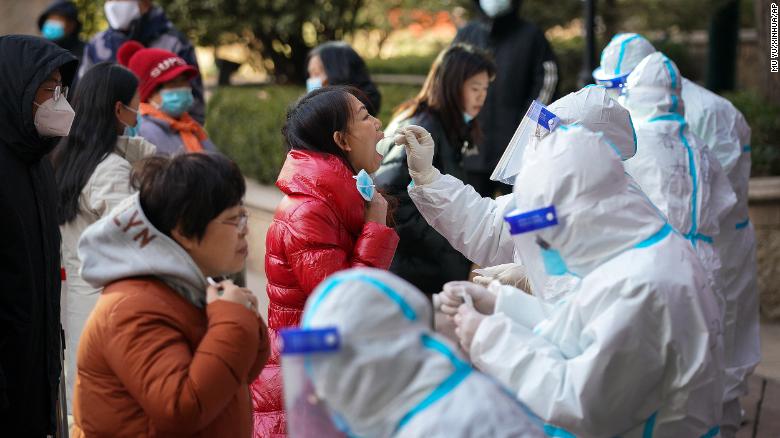China has locked down a city of 11 million people in its northern province of Hebei, in an effort to contain the country’s worst coronavirus flare-up in months.
Residents of Shijiazhuang, a provincial capital close to Beijing, have been barred from leaving the city, as major highways were blocked, train and bus stations closed and flights canceled.
The lockdown comes as a total of 117 Covid-19 infections — including 67 asymptomatic cases — were detected in Shijiazhuang on Wednesday. On Thursday, the city identified another 66 positive cases, according to the Hebei provincial health commission.
Since January 2, a total of 304 positive cases have been reported in Hebei — most of which in Shijiazhuang, official figures show. The city is located just 180 miles southwest of Beijing — about three hours’ drive away, or an hour on the high-speed rail.
At a press conference Thursday, municipal officials announced a ban on outbound travel for all residents and vehicles from Shijiazhuang, except for emergencies.
Within the city, gatherings are banned, all schools have been suspended, and residential communities and villages are also closed off.
The restrictions are some of the strictest imposed in China since the country largely contained the spread of the coronavirus in March. They are reminiscent of the draconian lockdown during the initial outbreak in the central city of Wuhan, a city of similarly sized population where the coronavirus was first detected in December 2019.
The outbreak in Shijiazhuang comes just weeks before the Lunar New Year holiday, the most important annual festival in China which typically sees hundreds of thousands of people traveling home to reunite with family.
Last year, the Chinese government sealed off Wuhan two days before the Lunar New Year, but millions of people had already left the city, potentially carrying the virus with them to their hometowns across the country.
This year, fearing that the Lunar New Year travels could again accelerate the spread of the virus, a growing number of local governments have advised residents against traveling home for the holiday, with civil servants and employees of state-owned companies ordered to stay unless special approval is given.
Stringent measures
In Shejiazhuang, authorities declared last week that the city was entering a “wartime mode” to fight the spread of the virus. A city-wide coronavirus testing drive was soon rolled out for all of its 11 million residents.
More than 3,000 health care workers have been deployed from other parts of the province to carry out the mass testing drive. As of noon on Thursday, more than 6 million samples have been collected, and over 2 million samples have been tested, deputy mayor Meng Xianghong said at the press conference Thursday. The mass testing identified 11 positive results for coronavirus, according to Meng.
On Thursday night, two medical teams — each with about 100 members — carrying testing kits and other equipments were dispatched from the eastern provinces of Jiangsu and Zhejiang to Shijiazhuang to assist the effort.
In addition, a hospital in the city has been cleared and designated to treat Covid-19 patients, with three more hospitals standing by, Meng said.
Swift and drastic measures such as mass testing, extensive contact tracing and strict lockdowns have defined China’s response to sporadic local outbreaks.
Last October, the eastern port city of Qingdao tested more than 10 million people in just four days over a dozen locally transmitted cases.
In late October, the prefecture of Kashgar in the far western region of Xinjiang rolled out mass testing for nearly 5 million people and imposed lockdown measures after a single asymptomatic coronavirus case was reported.
Potential weak link
But this time around, some public health experts in China said the reemergence of the virus in Shijiazhuang was detected too late, with rural areas a weak link in epidemic prevention and control.
Feng Zijian, deputy director of the Chinese Center for Disease Control and Prevention, told state broadcaster CCTV that the surging caseload suggested that the virus had been “spreading quietly for a while.”
The first confirmed case was detected reported on January 2 — a 61-year-old female villager on the outskirts of Shijiazhuang. In the following days, the majority of the new cases were detected in villages in the same district.
Lu Hongzhou, co-director of the Shanghai Public Health Clinical Center at Fudan University, told the state-run Global Times that the Shijiazhuang outbreak shows villages are a vulnerable link.
Epidemiological investigations conducted by the city’s local health authorities showed that many coronavirus patients who developed symptoms had first gone to local clinics, which are not equipped to conduct nucleic acid tests or give them proper treatment, according to the Global Times.
As the virus spread silently, villagers continued to take part in gatherings. Local health authorities have found that many infections were linked to funerals, weddings and other social gatherings, the report said.
According to the state-run Health Times, religious gatherings may have attributed to the spread of the virus, too.
“Apart from wedding banquets, some villagers also held religious activities at home every Wednesday, Friday and Sunday, or at least twice a week, participated by dozens of people, mainly the elderly,” a local official from the epicenter village of Shijiazhuang’s outbreak was quoted as saying.
These religious home gatherings often operate in a legal gray area separate from officially sanctioned church meetings. In recent years, Chinese authorities have cracked down on unsanctioned religious activities, closing prominent underground churches and jailing pastors.
>>>>

